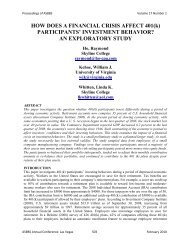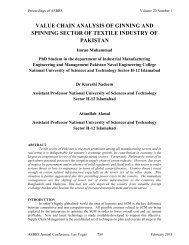stock repurchase announcements: a test of market ... - Asbbs.org
stock repurchase announcements: a test of market ... - Asbbs.org
stock repurchase announcements: a test of market ... - Asbbs.org
Create successful ePaper yourself
Turn your PDF publications into a flip-book with our unique Google optimized e-Paper software.
Importance <strong>of</strong> Geographic Space and Location<br />
Foreign investors much like domestic firms are subject to different locational factors. In her<br />
study <strong>of</strong> investment in China Cheng demonstrates that Japanese investors, once they decide on<br />
expanding in China due to cheap inputs, they are usually attracted to a province that has more<br />
favorable economic and business environment, such as skilled labor, business friendly policies,<br />
more solid infrastructure and higher quality <strong>of</strong> life. She suggests that: “conventional economic<br />
factors, like <strong>market</strong> potential, wages and land cost, only impose limited, if not negligible, impacts<br />
on Japanese investors’ location selection in China” (Cheng, 2007, p. 69). Cheng is skeptical<br />
about the Chinese government’s ability to attract more foreign investment to the central and<br />
western regions because <strong>of</strong> such crucial spatial considerations as the lack <strong>of</strong> agglomeration<br />
economies, the non-existence <strong>of</strong> industrial clusters in the interior, and a less favorable business<br />
climate.<br />
Several studies confirm that promotional efforts and agglomeration economies, including both<br />
urbanization and localization economies, play an important role in attracting foreign investment.<br />
Kim et al use a conditional logit regression model and their findings suggest that for smaller<br />
states the lack <strong>of</strong> agglomeration economies and locational disadvantages can be partly <strong>of</strong>fset by<br />
foreign investment attraction programs (Kim et al, 2007).<br />
The importance <strong>of</strong> foreign investment to the country’s economy has been finally recognized by<br />
the U.S. federal government as well, as it created the ‘Invest in America’ initiative within the<br />
U.S. Department <strong>of</strong> Commerce in March 2007. According to the federal government estimates<br />
foreign subsidiaries in the U.S. provided more than 5 million jobs for Americans. Many state<br />
governments also try to <strong>market</strong> themselves to foreign investors. For example the state <strong>of</strong> Ge<strong>org</strong>ia<br />
has been reported in the news to spend about $6 million last year to attract foreign investment.<br />
Some <strong>of</strong> the Southern states have been very successful in bringing in foreign auto manufacturers.<br />
The State <strong>of</strong> California has a number <strong>of</strong> programs through the California Business Investment<br />
Services (CalBIS) supporting foreign investment, which include assistance with the site selection<br />
and logistics, business consulting, networking with other economic actors, and providing essential<br />
economic and social data. CalBIS claims that they: “assist firms with expanding their existing<br />
operations and help them to compete more effectively and pr<strong>of</strong>itably in domestic and<br />
international <strong>market</strong>s. CalBIS provides technical assistance services to help businesses grow and<br />
prosper” (Cal. Lab., 2007). It is not clear how much CalBIS knows about firm location and<br />
especially economic and geographic spaces <strong>of</strong> those industries and firms that it tries to attract to<br />
California. Many regional and local governments also attempt to encourage foreign investment<br />
and they usually rely on various incentive packages, which are <strong>of</strong>fered to potential investors<br />
(Talley-Seijn, 2004).<br />
The main problem with traditional approaches and business attraction programs targeting foreign<br />
investment is the lack <strong>of</strong> any serious consideration <strong>of</strong> interdependence <strong>of</strong> geographic and<br />
economic spaces and almost no attention to economic spaces <strong>of</strong> different foreign firms singled<br />
out by public agencies and their respective industries. All these efforts will most likely have a<br />
limited success if they fail to incorporate the most important relationships between different<br />
economic agents and shifting comparative and competitive advantages within and between<br />
geographic and economic spaces.<br />
REGIONAL DEVELOPMENT EFFORTS<br />
Local and regional governments have traditionally been the only government agencies that relied<br />
heavily on geographic space in their development strategies. At the same time, in spite <strong>of</strong> the<br />
main focus on geographic space those governments <strong>of</strong>ten lack a clear understanding <strong>of</strong> their<br />
region’s potential and especially future opportunities. Yet, if their knowledge <strong>of</strong> the geographic<br />
ASBBS E-Journal, Volume 4, No.1, 2008 187

















